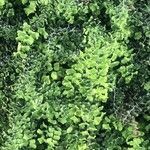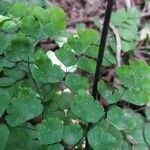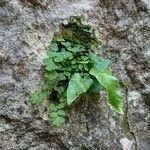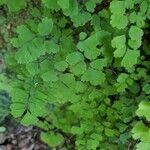Plants terrestrial or epilithic, 10-40 cm tall. Rhizomes creeping, slender, scales dense, brown, lanceolate, margins entire. Fronds remote or closely spaced; stipe castaneous-black, glossy, 3-20 cm, slender, base covered with same scales as rhizome, distally glabrous; lamina mostly 2-pinnate below middle, 1-pinnate above middle, ovate-triangular in outline, 6-25 × 8-16 cm, base cuneate, apex acute; pinnae 3-5 each side, obliquely ascending, stalk up to 15 mm; rachises, costae, and stalks same color as stipes, slightly zigzag, color passing into lamina base; basal pair of pinnae larger, 1(or 2)-pinnate, narrowly ovate in outline, 3-9 × 2.5-4 cm, apex obtuse; pinnae from second pair upward all similar but progressively smaller; pinnules 2-4 pairs per ultimate pinna, alternate, obliquely ascending; stalk castaneous-black, 1-2 mm, slender; blade subequal in size or basal pair slightly larger, 12-20 × 10-15 mm, thinly herbaceous, green or dark brown-green, both surfaces glabrous, base cuneate, sides entire, upper margin rounded, 2-4-lobed or divided into twiglike segments; sterile pinnules with apex obtuse, with marginal teeth broadly triangular or erose; fertile segments with apex truncate, straight or slightly depressed, entire or with erose teeth on both sides; terminal pinnules flabellate, usually larger, base narrowly cuneate, stalks up to 1 cm. Veins multidichotomously forked, reaching margins, visible on both surfaces. Sori 3-10 per pinnule, on apices of lobes of upper margin; false indusia yellowish green, brown when old, narrowly reniform or orbicular-reniform, membranous, upper margins flat and straight, entire, persistent. Perispore thickly granular.
Rhizome creeping, branched, up to 4 mm in diam., variously scaled; scales reddish brown, clathrate, subulate, up to 5 x 0.7 mm. Fronds erect, arching, or pendant, up to 420 mm long. Stipe firm, terete, dark brown to black, glossy, up to 215 mm long and 1.2 mm in diam., initially sparsely set with scales similar to those on rhizome. Lamina ovate to broadly ovate, up to 270 x 240 mm, up to 3-pinnate. Rachis and lower order axes dark brown and glossy. Pinnae alternate, basal pinna pair largest, unequally broadly ovate to narrowly elliptic, up to 140 x 80 mm, up to 2-pinnate, often basiscopically developed; petioles up to 23 mm long. Pinnules broadly ovate to narrowly elliptic, up to 62 x 40 mm, petioles up to 8 mm long; ultimate segments thinly herbaceous, pale to dark green, glabrous, narrowly to broadly cuneate, up to 26 x 25 mm, outer margins variously lobed, lobes oblong, obtuse, denticulate, venation evident, forked, branches end in teeth, petioles up to 3 mm long. Sori borne along outer lobe margins. Sporangia confined to veins in straight or nearly straight soral flaps up to 5 x 1 mm.
Stems short-creeping; scales golden brown to medium brown, concolored, iridescent, margins entire or occasionally with single broad tooth near base. Leaves lax-arching or pendent, closely spaced, 15--75 cm. Petiole 0.5--1.5 mm diam., glabrous, occasionally glaucous. Blade lanceolate, pinnate, 10--45 × 4--15 cm, glabrous, gradually reduced distally; proximal pinnae 3(--4)-pinnate; rachis straight to flexuous, glabrous, not glaucous. Segment stalks 0.5--3.5 mm, dark color extending into segment base. Ultimate segments various, generally cuneate or fan-shaped to irregularly rhombic (plants in American southwest occasionally with segments nearly round), about as long as broad; base broadly to narrowly cuneate; margins shallowly to deeply lobed, incisions 0.5--7 mm, occasionally ± laciniate, sharply denticulate in sterile segments; apex rounded to acute. Indusia transversely oblong or crescent-shaped, 1--3(--7) mm, glabrous . Spores mostly 40--50 µm diam. 2 n = 120.
Rhizome short-creeping, suberect, branched, to 5 mm diam.; scales concolorous, yellow-brown, with entire margins. Fronds tufted, to 36 cm long. Stipe to 18 cm long, glossy, glabrous, brittle. Lamina 2–3-pinnate, triangular, 5–20 cm long, 4–15 cm wide, delicate, membranous. Pinnae rectangular or elliptic; rachis flexuose, wiry. Pinnules ovate to triangular, shortly stalked throughout, symmetric and cuneate-flabellate or subdimidiate, glabrous; distal margins irregularly and deeply lobed, denticulate when sterile; stalks not articulated; veins red-brown near junction with stalk, otherwise pale. Sori 1–10 along distal margins, 1 or 2 per lobe; soral flaps oblong to subreniform, not or scarcely indented into the lamina margin, glabrous. Spores 64 per sporangium, pale brown; perine scabrous; largest diam. (43–) 48.1 (–60) µm.
Rhizome short-creeping, 1.5–2.5 mm thick, its slender dark brown scales 1.5–3 mm, scarcely 0.5 mm wide; lvs scattered, lax, mostly 1–4(–5) dm overall; petiole purplish-black, nearly or fully as long as the blade; blade (once or) twice (or in part thrice) pinnate, mostly 2–4 times as long as wide; pinnae alternate, few, mostly 5–12 on each side; ultimate segments petiolulate, subflabellate or rhombic, deeply parted with dentate lobes, lacking a midrib; fertile pinnules slightly smaller than the sterile; 2n=60. Moist calcareous rocks and banks; Va., Ky., Mo., S.D., and Utah, s. to the tropics, and in warmer parts of the Old World; sometimes escaped farther north.
Rhizome creeping, set with subulate, reddish brown, entire rhizome-scales c. 3 mm long. Fronds spaced up to 10 mm apart, arching, herbaceous; stipe castaneous or ebeneous, glabrous; lamina usually narrowly ovate-deltate, up to 260 x 190 mm, 3-pinnate; pinnules cuneate, entire or irregularly shallowly to deeply lobed, petiolulate, minutely crenate-dentate on outer margin of sterile pinnules, veins ending in the teeth, glabrous on both surfaces, often glaucous green, thinly to firmly herbaceous, up to 27 x 20 mm; rhachis ebeneous, glabrous. Sori borne along outer margin of pinnules; indusial flaps lunate to oblong, glabrous, up to 5 x 1-1.5 mm.
Rhizomes creeping, scaly. Stipes and rachises glabrous except at very base. Laminae ovate, 4-25 × 2-8 cm, 2-3-pinnate at base. Primary pinnae alternate, 4-8 on each side of rachis. Ultimate pinnules broadly obovate, rhombic, or flabellate, 5-20 × 6-20 mm, cuneate at base, with stalk attached ± centrally, usually deeply divided into 2-6 lobes, glabrous, yellow green. Indusia ± oblong, lacking sinuses, extending up to 5 mm along margin, glabrous, 1-8 per pinnule on outer margin only.
Terrestrial or epilithic. Rhizome creeping. Fronds closely spaced, erect to arching or pendent, 2-or 3-pinnate, lamina broadly triangular to narrowly ovate, up to 200 x 180 mm, glabrous; pinnules obtriangular, persistent, deeply incised, margins shallowly serrate, veins ending in marginal serrations. Sporangia in oblong, lunulate or reniform sori borne on lobe apices, with pale brown, glabrous indusial flap.
Rhizomatous perennial. Fronds arching, soft, stipe dark, glossy, glabrous, lamina ovate-deltate, 3-pinnate, pinnules cuneate, shallowly to deeply lobed, petiolulate, minutely crenate-dentate, veins ending in teeth. Sori along outer margins of pinnules, indusial flaps crescent-shaped to oblong.
Rhizomatous perennial. Fronds arching, soft, stipe glabrous, lamina ovate-deltate, 3-pinnate, pinnules cuneate, shallowly to deeply lobed, minutely crenate-dentate, veins ending in teeth. Sori along outer margins of pinnules, indusial flaps lunate to oblong.
Rhizome creeping, set with reddish brown, entire rhizome scales ± 3 mm long. Fronds 3-pinnate; veins of sterile pinnules ending in marginal teeth; pinnules cuneate, entire or irregularly shallowly to deeply lobed. Sori oblong to lunate.







